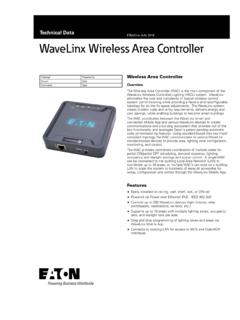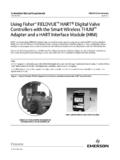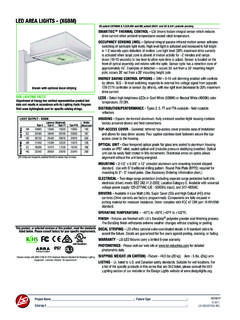Transcription of Introduction What Exactly Is Wireless DMX?
1 What You Need To Know About Wireless DMX By Gary Fails President, City Theatrical, Inc. Introduction Wireless DMX has become a technology of growing importance in the entertainment, architectural, and architainment fields and has given designers the ability to create lighting effects at lower cost and in places that were not possible before. This White Paper will give you a quick lesson in what you need to know to be a user of Wireless DMX. While not getting too deeply into the radio science of how they work, this document takes you into the practical aspects of what designers, users, and specifiers of Wireless DMX will face as they learn about his new and growing area of entertainment technology.
2 What Exactly Is Wireless DMX? Simply stated, Wireless DMX is a way of getting DMX data from point A to point B without using cable. DMX cable and the labor to install it are expensive, and using Wireless DMX can save time and money as well as allowing DMX data to be run to places that cable can t reach, such as across a river, a highway, or to the top of a tall building. A Brief Refresher: What is DMX? If you are in the field of entertainment technology you are familiar with DMX. (The official terminology is DMX512-A but I ll refer to it in its common usage in this paper, DMX.) DMX is the communications protocol that was created by the entertainment industry in order to have a common language for lighting controllers to speak to lighting devices such as dimmers or color scrollers.
3 It enables any lighting controller from any manufacturer to communicate with any lighting device from any other manufacturer. In the early days of DMX, data needs in entertainment were relatively simple, with perhaps a DMX run to the dimmer racks and some DMX lines run for color scrollers and fog machines. The growth of moving lights later added a need for DMX data in more locations. And the recent Introduction and growth of LED lighting fixtures has created a need for DMX data at nearly every lighting location in a venue. DMX data has traditionally been distributed around the venue via DMX cable, whether portable cable with five pin XLR connectors, or via permanent runs in conduit.
4 Wireless Data That You Already Use Every Day Coinciding with the growing need for DMX in every location has been the growth of home and office Wi-Fi systems and a growing familiarity and expectation of users of the ability to send computer data without wires. Nearly every home and office, and most public places expect to have Wi-Fi available for our computing, tablet, and smart phone needs. Unfortunately, Wi-Fi based distribution of DMX is presently not sufficiently reliable for the mission critical challenges of the entertainment world. We tolerate slow speeds on Wireless computer systems and we tolerate dropouts on our smart phones, but we could never tolerate that level of uncertainty on a production.
5 Could you imagine waiting several seconds (or longer) to execute an important cue on a show? The level of quality required for professional products rivals military standards of reliability. It must work, it must work with imperceptible latency, and it must work every time. 2 A History of Wireless DMX Technology To meet the necessary quality and reliability levels, manufacturers of high quality Wireless DMX products use radios that utilize a Frequency Hopping Spread Spectrum (FHSS) broadcast system. This system was developed for the military to encrypt radio signals and it happens to work very well for DMX data. Early Wireless DMX systems (beginning in the early 2000s) were used primarily for controlling Wireless DMX in limited amounts on shows, often for controlling battery operated dimming on moving set pieces so these scenic elements could move around stage without wires trailing.
6 Most Broadway and West End musicals had some Wireless DMX on them in this form. These early Wireless DMX systems were actually quite powerful and reliable, but they had the flaw of overpowering any other Wireless equipment in their frequency. They didn t play well with others. The next generation of Wireless DMX systems added advanced abilities to tune their broadcasts to produce a small radio footprint while still producing excellent fidelity and performance. Present systems utilize state of the art radios with excellent performance and offer a wide range of technologies to suit all users, such as adaptive frequency hopping which picks out only open radio frequencies to broadcast on (thereby not interfering with or being interfered by other signals), devices with advanced user interfaces that allow the operator to precisely tune the performance to optimize the radio signal for his venue s unique radio situation, and Wireless DMX systems that are completely plug and play and require no user intervention at all to perform perfectly.
7 How To Set Up Your Wireless DMX System Most modern Wireless DMX products are based on a device called a Transceiver. This is a radio device that can be user selected to be either a Transmitter or a Receiver. Since multiple Receivers can be used with each Transmitter, users are not forced to guess Exactly how many Transmitters or Receivers they need to purchase. By purchasing only Transceivers, the users can assign the devices to be either a Transmitter or Receiver on a show to show basis. The Transmitter receives wired DMX via its DMX in port from anywhere in the show s DMX chain. DMX is broadcast from the Transmitter to all Receivers in the system which receive this radio signal and pass it on to lighting devices via a DMX cable linking the Receiver to the device.
8 Additional lighting devices can be daisy-chained onward from there. Transmitters and Receivers must be selected to speak to each other. This is accomplished either through an on board user interface, or by other means such as pushing a link button, depending in the manufacturer s system. Some systems are automatically and permanently linked and require no user intervention to link together. Once Transmitter and Receiver are linked and DMX data is sent to the Transmitter, DMX data will be available at the Receiver and the target DMX devices will operate Exactly as if a cable had been run. Most systems take only a few minutes or less to set up. What We Have Learned City Theatrical has been developing and manufacturing professional quality Wireless DMX systems since 2001.
9 We ve played a part in many of the largest professional productions in the world including nearly every Broadway and West End show and tour that uses Wireless DMX, architectural installations around the world, many major music tours and major events such as the London Olympics. We are often asked questions like these: 3 What Frequency Do You Use? City Theatrical broadcasts in the ISM band, which requires no license for use. We use that range because it provides the best combination of bandwidth (the ability to carry the required amount of data) and the ability to pass through objects. Since in show business we are often broadcasting through scenery, this is vital.
10 Some manufacturers use other areas of the spectrum and accept the resulting tradeoffs. What Is The Range? As a rule of thumb, we say 100m indoors and 500m outdoors using standard omni-directional antennas. These figures depend on conditions such as: Range is increased by Transmitter and Receiver being in line of sight Range is increased by placing antennas as high as possible Range can be dramatically increased (as much as 10X) by using specialized antennas Range is decreased by broadcasting through objects such as scenery, walls, or trees Range is decreased by broadcasting through people Range may be decreased by reflections off walls or buildings Range is decreased when signal strength is decreased due to interference from other radios How Many Universes Can Be Broadcast At One Time?






